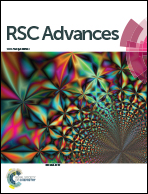Glucose detection using SERS with multi-branched gold nanostructures in aqueous medium
Abstract
Gold nanoparticles (AuNPs), multi-branched gold nanoparticles (MBGNs), and silica-coated MBGNs (MBGNs-silica) were studied for rhodamine B (RB) and α-glucose detection at low concentration. The MBGNs SPR band in the NIR, which is tunable, is useful for SERS that was demonstrated using rhodamine B and α-glucose as probe molecules with detection limits of 50 pM and 5 mM (90 mg dL−1), respectively, much lower than that using regular AuNPs. The SERS signals of RB and α-glucose using MBGNs-silica are further enhanced with respect to AuNPs and MBGNs, which is attributed to the aggregation of the MBGNs and a stronger interaction. In the case of α-glucose, the functionalization process performed to both, α-glucose molecules and MBGNs, improves the interaction and allows measurements at low concentration.


 Please wait while we load your content...
Please wait while we load your content...